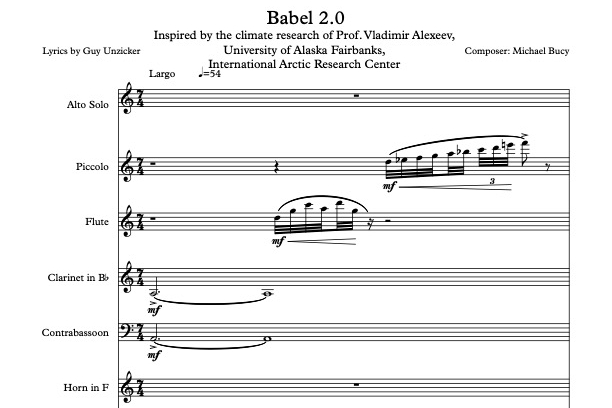What climate change in Alaska sounds like as a musical composition
“What if we tied climate science to music and we inspired people to relate to that information in a different way?”

Climate change in Alaska is something that residents and scientists can easily see, measure and feel. They can see the loss of sea and glacier ice, feel the warmer air and water temperature and track the shifts in marine and terrestrial animal populations.
But is climate change something that people can hear? Now, thanks to a blend of science and music, it is.
A new project has paired University of Alaska Fairbanks scientists with Alaska musicians to put climate change information into song.
The project was spearheaded by scientist Kaja Brix, who worked for several years in Juneau studying marine mammals for the National Oceanic and Atmospheric Administration and is currently posted at UAF.
At the university, she is part of a program addressing Arctic Alaska policy issues and has been trying to figure out how to better communicate science information to the public. Brainstorming with a longtime Juneau friend, artist Marta Lastufka, produced idea of expressing climate science in music.
“What if we tied climate science to music and we inspired people to relate to that information in a different way?” said Brix, who heads NOAA Fisheries’ Arctic program. “We can be inspired by the feeling that the music gives us about what’s happening.”
The first completed musical product is called Babel 2.0, after the Biblical story of the collapsed Tower of Babel. Crafted to express in music some recent scientific findings about the way that Bering Strait-area warming affects weather patterns thousands of miles away, it had an inaugural performance in Juneau in November.
It was written by Juneau composer and music teacher Michael Bucy, Lastufka’s husband. His scientific partner is Vladimir Alexeev of UAF’s International Arctic Research Center.
Alexeev co-authored a study of the unusual warming in the Bering Strait region in the winters of 2017-18, a time of midwinter ice meltdown resulting in unprecedented open water for that season. Alexeev and his Japanese research colleagues found that warmth in the marine waters extended out of that big hole into sea ice far up into the atmosphere, skewing the jet stream and bringing extreme cold to the East Coast.
“What’s happening in the Bering Strait area is a climate disaster now, and not just for that area, but for elsewhere,” said Andreev, who published his findings in 2019 in the journal Nature. “We are seeing the impacts of changes in the Bering Strait area far downstream on the East Coast with all the unusual cold weather in the winter.”
Alexeev said he considers it important — but often challenging for scientists — to convey climate information to non-scientists.
“Sometimes I see people do not understand me, but I try my hardest,” he said. “It is not easy. We are pretty much set in our own bubble, speaking to nerds like us.”
Enter Bucy.
To put Alexeev’s findings into musical form, Bucy said he used “musical texture,” which meant the assignment of different instruments to represent the various environmental changes happening as the ocean warms. Notes from low-range instruments like the upright bass and bassoon represent the movement of warmth rising from the ocean depths, for example, and high-range instruments like the piccolo and flute express what is happening high in the stratosphere. Brass instruments, with their metallic sound, represent the hands of humans and mechanized industry, he said.
Bucy also wrote Babel 2.0 with a tempo that speeds up over the approximately 4-minute duration, representing increasing urgency. The piece also includes as lyrics a poem written by Juneau writer Guy Unzicker that uses a halo metaphor to describe the jet stream that Andreev and his colleagues describe as being skewed by warming and loss of ice in the Bering Strait region.
“The idea of the jet stream being a halo on the top of the earth and having it broken by something we’re doing, it was emotional,” Bucy said.
In the inaugural performance of Babel 2.0, Lastufka was the vocalist singing Unsicker’s poem.
For Bucy, creating music from his new understanding of climate science was a bit cathartic. He said he follows the science “as much as I can follow it without crashing into despair.” So using his music to convey information made him feel like he was doing something useful to address the problem. “Thank God I’m doing something — anything,” he said.
Additional musical pieces from other science-composer teams are in the works, Brix said. Among the topics being explored in those pieces are glacial ice loss and outburst flooding and the information about High Arctic sea-ice loss gathered during the year-long MOASiC expedition, she said.
The musicians and scientists hope to have concerts in Juneau and Fairbanks where all the pieces will be performed, Brix said.